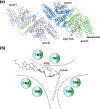Structural enzymology of cholesterol biosynthesis and storage
- PMID: 35398802
- PMCID: PMC9189044
- DOI: 10.1016/j.sbi.2022.102369
Structural enzymology of cholesterol biosynthesis and storage
Abstract
Cholesterol biosynthesis occurs in the endoplasmic reticulum (ER). Its lego-like construction from water-soluble small metabolites via intermediates of increasing complexity to water-insoluble cholesterol requires numerous distinct enzymes. Dysfunction of the involved enzymes can cause several human inborn defects and diseases. Here, we review recent structures of three key cholesterol biosynthetic enzymes: Squalene epoxidase (SQLE), NAD(P)-dependent steroid dehydrogenase-like (NSDHL), and 3β-hydroxysteroid Δ8-Δ7 isomerase termed EBP. Moreover, we discuss structures of acyl-CoA:cholesterol acyltransferase (ACAT) enzymes, which are responsible for forming cholesteryl esters from cholesterol to maintain cholesterol homeostasis in the ER. The structures of these enzymes reveal their catalytic mechanism and provide a molecular basis to develop drugs for treating diseases linked to their dysregulation.
Copyright © 2022 Elsevier Ltd. All rights reserved.
Conflict of interest statement
Conflict of interest statement Nothing declared.
Figures



Similar articles
-
NSDHL, an enzyme involved in cholesterol biosynthesis, traffics through the Golgi and accumulates on ER membranes and on the surface of lipid droplets.Hum Mol Genet. 2003 Nov 15;12(22):2981-91. doi: 10.1093/hmg/ddg321. Epub 2003 Sep 23. Hum Mol Genet. 2003. PMID: 14506130
-
Localization of mammalian NAD(P)H steroid dehydrogenase-like protein on lipid droplets.J Biol Chem. 2003 Sep 19;278(38):36819-29. doi: 10.1074/jbc.M301408200. Epub 2003 Jul 1. J Biol Chem. 2003. PMID: 12837764
-
Regulation of ovarian cholesterol metabolism: control of 3-hydroxy-3-methylglutaryl coenzyme A reductase and acyl coenzyme A:cholesterol acyltransferase.Endocrinology. 1981 Apr;108(4):1476-86. doi: 10.1210/endo-108-4-1476. Endocrinology. 1981. PMID: 7472277
-
Acyl-CoA:cholesterol acyltransferases (ACATs/SOATs): Enzymes with multiple sterols as substrates and as activators.J Steroid Biochem Mol Biol. 2015 Jul;151:102-7. doi: 10.1016/j.jsbmb.2014.09.008. Epub 2014 Sep 12. J Steroid Biochem Mol Biol. 2015. PMID: 25218443 Free PMC article. Review.
-
Acyl-coenzyme A:cholesterol acyltransferase.Annu Rev Biochem. 1997;66:613-38. doi: 10.1146/annurev.biochem.66.1.613. Annu Rev Biochem. 1997. PMID: 9242919 Review.
Cited by
-
Metabolic dysfunctions following chronic oral corticosterone are modified by adolescence and sex in mice.Physiol Behav. 2023 Oct 1;269:114289. doi: 10.1016/j.physbeh.2023.114289. Epub 2023 Jul 6. Physiol Behav. 2023. PMID: 37422081 Free PMC article.
-
Emopamil-Binding Protein Inhibitors for Treating Multiple Sclerosis.ACS Med Chem Lett. 2023 Sep 6;14(10):1318-1319. doi: 10.1021/acsmedchemlett.3c00366. eCollection 2023 Oct 12. ACS Med Chem Lett. 2023. PMID: 37849545 Free PMC article.
-
Oral and Non-Oral Cholesterol-Lowering Drugs with PCSK9 and Other Biomolecules as Targets: Present Status and Future Prospects.Biomolecules. 2025 Mar 22;15(4):468. doi: 10.3390/biom15040468. Biomolecules. 2025. PMID: 40305153 Free PMC article. Review.
-
Emopamil-Binding Protein Inhibitors for Treating Multiple Sclerosis.ACS Med Chem Lett. 2024 Jan 4;15(2):163-164. doi: 10.1021/acsmedchemlett.3c00555. eCollection 2024 Feb 8. ACS Med Chem Lett. 2024. PMID: 38352824 Free PMC article.
-
Advances in understanding the role of squalene epoxidase in cancer prognosis and resistance.Mol Biol Rep. 2025 Jan 27;52(1):162. doi: 10.1007/s11033-025-10276-x. Mol Biol Rep. 2025. PMID: 39869140 Review.
References
-
- Luo J, Yang H and Song BL (2019) Mechanisms and regulation of cholesterol homeostasis. Nature reviews. Molecular cell biology - PubMed
-
- Cerqueira NM, Oliveira EF, Gesto DS, Santos-Martins D, Moreira C, Moorthy HN, Ramos MJ and Fernandes PA (2016) Cholesterol Biosynthesis: A Mechanistic Overview. Biochemistry, 55, 5483–5506. - PubMed
Publication types
MeSH terms
Substances
Grants and funding
LinkOut - more resources
Full Text Sources
Medical

